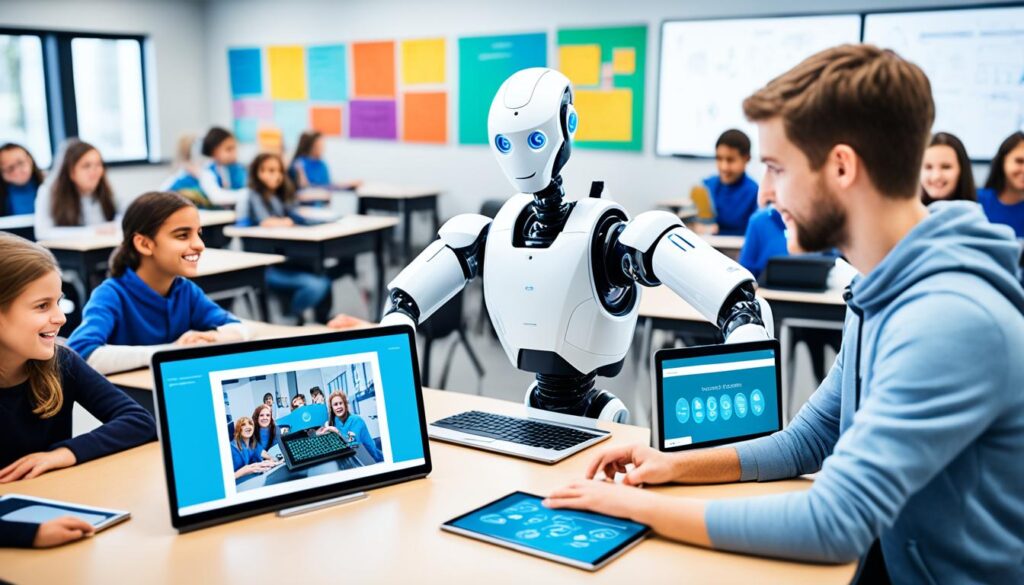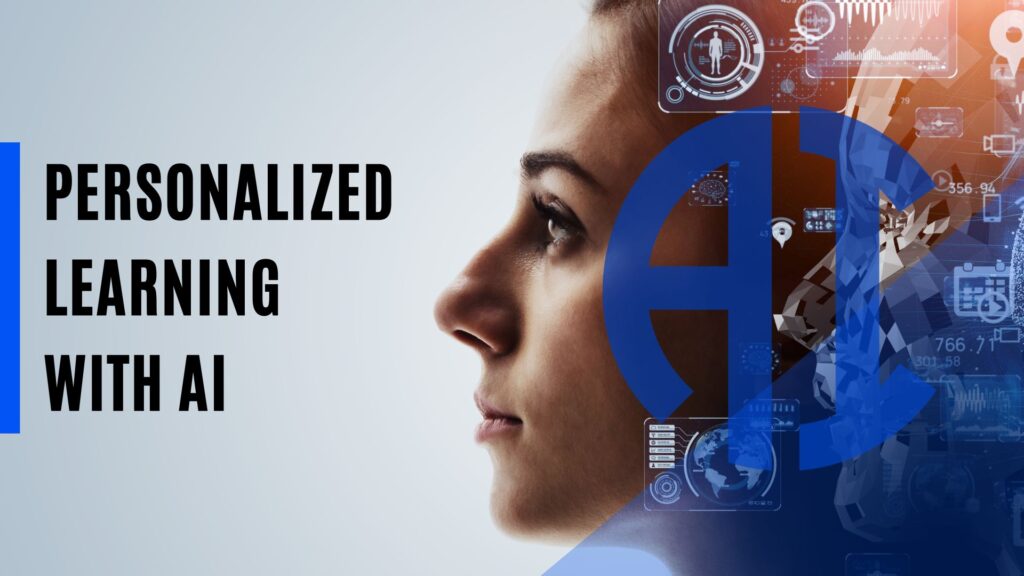Can artificial intelligence (AI) revolutionize student assessment and improve learning outcomes?
As an educator, you strive to provide your students with the best learning experience possible. You understand the importance of assessing their progress and tailoring instruction to their individual needs. But with limited time and resources, it can be challenging to effectively evaluate each student’s performance and provide timely feedback.
This is where AI comes into play. By leveraging AI technology, educators can enhance student assessment in ways that were previously unimaginable. With AI-powered assessment tools, you can personalize learning experiences, provide immediate feedback, and analyze student performance in real time.

In this article, we will explore how AI can transform student assessment and improve learning outcomes. We will dive into topics such as personalized learning experiences, adaptive testing, accessibility tools, faster performance analysis, automated scoring, student remediation plans, and more. We will also address important considerations around bias and ethical use of AI.
So, how can AI revolutionize student assessment and enhance learning outcomes? Let’s find out.
Personalized Learning Experiences & Adaptive Testing
When it comes to education, every student is unique with their own strengths, weaknesses, and preferred learning styles. Thanks to advancements in artificial intelligence (AI), personalized learning experiences and adaptive testing are now possible, revolutionizing the way students learn and demonstrate their knowledge.
AI-driven personalized learning platforms analyze individual student data to create tailored learning experiences. These platforms can generate custom content based on a student’s needs, ensuring that they receive material that is most relevant to their learning goals. Furthermore, AI-powered platforms provide individualized pacing, allowing students to learn at a pace that suits them best.
One of the biggest advantages of AI in education is its ability to offer targeted remediation. By identifying areas of difficulty, AI algorithms can provide additional resources and support to help students overcome challenges. This personalized approach to remediation can make a significant difference in a student’s academic success.
Continuous assessment is another benefit of AI in education. Through real-time data analysis, AI systems can monitor student performance and provide instant feedback. This enables students to track their progress and make necessary adjustments to improve their learning outcomes.
Implementing personalized learning experiences and adaptive testing through AI-driven platforms fosters student engagement and motivation, as they receive customized attention and support. With AI as their learning companion, students can embark on a journey of self-discovery, unlocking their full potential.
The use of AI for personalized learning experiences and adaptive testing is revolutionizing education, providing students with a tailored educational path that meets their unique needs. By harnessing the power of AI-driven personalized learning platforms, students have the opportunity to thrive academically and discover their true capabilities.
Accessibility Tools
AI has the potential to revolutionize accessibility in education, making it more inclusive and accessible for all students. With AI-powered tools, educational materials can be transformed to cater to the diverse needs of learners, ensuring equal access to quality education.
One of the key AI applications for accessibility is text-to-speech technology. Through this technology, written text can be converted into spoken language, benefiting students with visual impairments, dyslexia, or reading difficulties. This enables them to access educational content more effectively and engage with the material.
Another powerful tool is speech-to-text technology, which transcribes spoken language into written text. This feature assists students who struggle with handwriting, typing, or verbal communication, allowing them to participate fully in class activities and assessments.
AI also offers language translation and localization tools, allowing educational materials to be available in multiple languages. This promotes inclusivity and ensures that language barriers do not hinder students’ access to knowledge.
Customizable fonts and formatting options provided by AI empower students with specific visual needs to personalize their learning experience. They can choose fonts, colors, and formatting that enhance readability and reduce visual fatigue.
Content summarization and simplification tools powered by AI help students with cognitive disabilities to comprehend complex text. These tools automatically condense and simplify content, making it more accessible and easier to understand.
Real-time captioning and sign language interpretation, made possible by AI, enable students with hearing impairments to access audio content and live presentations. This ensures that they do not miss out on valuable information and can fully engage in classroom activities.
Personalized learning pathways, supported by AI, allow students to progress through their educational journey at their own pace. Adaptive learning platforms create individualized learning paths based on students’ strengths, weaknesses, and learning styles, providing tailored content and support.
Integration of assistive devices, such as screen readers or braille displays, with AI-powered tools enhances accessibility for students with disabilities. These devices work seamlessly with AI technologies to provide a more inclusive learning experience.
Finally, AI enables accessible content creation, ensuring that educators have the necessary tools to produce materials that meet the needs of all students. From creating accessible documents to generating alternative formats, AI simplifies and streamlines content creation processes.
This wide range of AI-powered accessibility tools empowers students with disabilities and promotes inclusivity in education, enabling every learner to reach their full potential.
Faster Performance Analysis
With the integration of AI in student assessment, you can benefit from faster performance analysis. AI technology assesses and scores student work in real-time, eliminating the need for manual grading and reducing the waiting time for feedback. This means that your students can receive immediate feedback, allowing them to track their progress and make necessary improvements promptly.
The real-time analysis and feedback provided by AI can significantly boost student engagement. By receiving instant feedback, students are more likely to stay motivated and actively participate in the learning process. As an educator, you can also make timely instructional adjustments based on the real-time analysis, ensuring that your teaching methods are effective and aligned with the needs of your students.
Additionally, AI assessment software allows you to view data and analytics in real-time. This gives you valuable insights into student performance, allowing you to make informed decisions and adjust your instruction as needed. By having access to real-time data, you can easily identify areas where students may be struggling and provide targeted support and resources to help them succeed.
One of the key benefits of faster performance analysis through AI is the reduction of your workload as a teacher. Through automation, AI eliminates the time-consuming task of manually grading assignments, freeing up your time to focus on other crucial aspects of educational instruction.
Overall, by leveraging AI for faster performance analysis, you can provide real-time feedback, enhance student engagement, make data-driven instructional decisions, and reduce your workload as a teacher.
Reduce Human Error with Automated Scoring
Automated scoring powered by AI is a powerful tool that reduces human error and ensures more accurate grading in the assessment process. With AI-enabled assessment, educators can assess student work, including long-form answers like essays, in a more consistent and equitable manner.
By leveraging AI for automated scoring, educators can provide feedback to an entire class quickly and accurately, saving time and ensuring fair evaluation. This technology allows for efficient and objective grading, reducing the potential for subjective biases.
Moreover, automated scoring enables educators to leverage student data in new and impactful ways. By automating the grading process, AI assessment tools help educators work more efficiently and provide timely feedback to students.
Student Remediation Plans
A key benefit of utilizing AI in student assessment is its ability to develop personalized learning plans for students who require remediation. By leveraging AI-based assessment tools, educators can identify specific areas where students are struggling and create tailored strategies for improvement.
An essential feature of AI-based assessment is its capacity to provide real-time feedback and facilitate communication between teachers, students, and parents. This enables a seamless exchange of information, allowing for immediate intervention and support.
Through the collection and analysis of data, AI can efficiently identify at-risk students, ensuring targeted support is delivered promptly. By understanding students’ individual abilities and learning patterns, AI-driven personalized learning can be tailored to their specific needs, fostering a more effective and inclusive educational experience.
Collaboration among educators, administrators, and AI specialists is crucial for the successful implementation of student remediation plans. By working together, they can leverage the power of AI to enhance students’ learning experiences, promote academic success, and bridge the gap for struggling learners.
Making AI an Asset Education
Integrating AI in education can have a transformative impact on teaching and learning experiences. However, to fully harness the potential of AI, it is crucial to establish clear educational goals. By defining these goals, educators can effectively assess available AI tools and resources to select the most appropriate solutions for their educational context and objectives.
Training and professional development play a vital role in ensuring the effective use of AI in education. Educators need to acquire the necessary knowledge and skills to leverage AI tools and integrate them seamlessly into their teaching practices. Ongoing professional development allows educators to stay up-to-date with the latest advancements in AI and continuously refine their instructional strategies.
One of the key advantages of AI in education is the ability to provide customizable learning experiences. AI can tailor educational content to meet individual student needs, enabling personalized and adaptive learning. By incorporating AI-driven platforms, educators can promote engagement and interactivity, making learning more enjoyable and effective.
In addition to enhancing the learning experience, AI can also streamline administrative tasks. AI-powered systems can automate tasks such as grading, scheduling, and data management, freeing up time for educators to focus on instruction and student support. This automation also enables educators to gain valuable insights through data analysis, helping them make informed decisions to improve teaching and learning outcomes.
Feedback mechanisms are essential for student growth and development. AI facilitates immediate and targeted feedback, allowing students to receive real-time assessments of their performance. This enables students to identify areas for improvement and make necessary adjustments, ultimately enhancing their learning progress.
Accessibility and inclusivity should be at the forefront when integrating AI in education. AI tools should be designed to cater to the diverse needs of learners, ensuring that all students, including those with disabilities, can access and benefit from educational resources. Features such as text-to-speech, speech-to-text, and customizable formatting enhance accessibility, while AI-powered captioning and translation services enable multilingual support and inclusivity.
Staying informed about advancements in AI assessment software is crucial to ensure continuous improvement in education. Educators should actively seek information about new developments and research in the field of AI, attending conferences, workshops, and engaging with professional communities. By staying informed, educators can make informed decisions and effectively navigate the ever-evolving landscape of AI in education.

Conclusion
The integration of artificial intelligence (AI) into student assessment has the potential to significantly enhance learning outcomes and revolutionize education. By leveraging AI, educators can personalize education, provide immediate feedback, improve accessibility, enable faster performance analysis, reduce human error through automated scoring, and develop student remediation plans.
Integrating AI into the classroom not only enhances teaching and learning experiences but also improves administrative tasks and provides valuable data insights. AI-powered tools can customize learning experiences, promote engagement and interactivity, and streamline administrative processes. The analysis of data and insights obtained through AI assessment can inform instructional decisions and help educators optimize student performance.
Despite the enormous benefits of AI in student assessment, it is essential to address considerations around bias and ethical use. To fully harness the potential of AI, investing in testing research and development is crucial, along with providing appropriate training for educators and administrators. This will ensure the maximization of benefits and contribute to the advancement of education.
FAQ
How can AI enhance student assessment?
AI empowers educators to process more information, develop new materials quickly, and provide individualized assessment items that adapt to student needs. AI enables personalized learning experiences, immediate feedback, and enhances overall learning outcomes.
What is personalized learning and adaptive testing?
Personalized learning uses AI to analyze individual student strengths, weaknesses, and learning styles to create custom content and provide individualized pacing for students. Adaptive testing adapts assessment items based on a student’s needs and areas of difficulty.
How does AI improve accessibility for students?
AI-powered tools such as text-to-speech, speech-to-text, language translation, customizable fonts, and formatting make educational materials more inclusive and accessible to students with disabilities. Real-time captioning and sign language interpretation enable students with hearing impairments to access audio content and live presentations.
How does AI enable faster performance analysis?
AI assesses and scores student work in real-time, providing immediate feedback to students. This eliminates the need for manual grading and reduces waiting time. Real-time analysis and feedback can boost student engagement and allow for timely instructional adjustments.
How does AI reduce human error in student assessment?
AI-enabled assessment scoring ensures more accurate grading of student work, including long-form answers like essays. This provides consistent and equitable evaluation, saves time, and allows educators to leverage student data in meaningful ways.
How can AI be used to develop student remediation plans?
AI-based assessment provides real-time feedback and communication among teachers, students, and parents. By collecting and analyzing data, at-risk students can be identified, and targeted support can be delivered to help them succeed.
How can AI be an asset in education?
AI can be used to customize learning experiences, enhance administrative tasks, analyze data for insights, provide feedback mechanisms, and promote accessibility and inclusivity. It should be integrated into education with clear goals, training, and selection of appropriate AI solutions.

